史上最全 马来西亚 中英双语介绍
- 格式:docx
- 大小:438.23 KB
- 文档页数:14
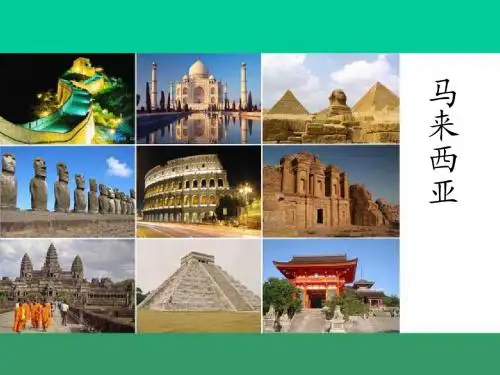
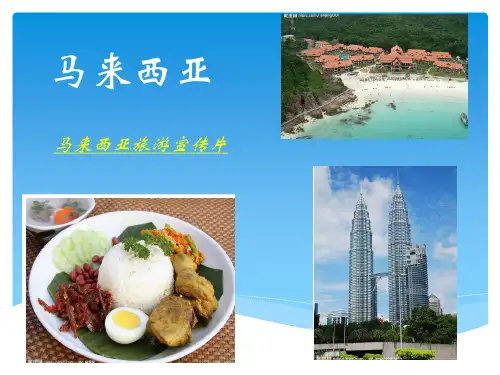

马来西亚 编辑
马来西亚联邦(英语:Federation of Malaysia,前身马来亚),通称马来西亚(Malaysia),简称大马。
马来西亚被南中国海分为两个部分:位于马来半岛的西马来西亚,北接泰国,南部隔着柔佛海峡,以新柔长堤和第二通道连接新加坡;东马来西亚,位于婆罗洲(加里曼丹岛)的北部,南接印度尼西亚,文莱国夹在沙巴州和砂拉越州之间。
1957年8月31日,联盟主席东姑阿都拉曼宣布马来亚独立。
1963年,马来亚联同新加坡、沙巴及沙捞越组成了马来西亚联邦。
1965年8月,新加坡退出马来西亚联邦。
[1] 首都为吉隆坡,联邦政府则位于布城。
马来西亚是东南亚国家联盟的创始国之一,环印度洋区域合作联盟、亚洲太平洋经济合作组织、英联邦、不结盟运动和伊斯兰会议组织的成员国。
主要参与的军事行动有五国联合防卫和联合国维和行动。
马来西亚是一个多民族、多元文化的国家。
宪法规定伊斯兰教为国教,保护宗教信仰自由。
政府系统密切仿照威斯敏斯特的议会制度和法律制度是基于普通法。
国家元首是国王,被称为最高元首。
政府首脑是总理。
马来西亚是一个新兴的多元化经济国家。
经济在1990年代突飞猛进,为“亚洲四小虎”国家之一,是资本主义国家。
马来西亚已成为亚洲地区引人注目的多元化新兴工业国家和世界新兴市场经济体。
旅游业是马来西亚的第三大外汇收入来源,知识经济服务业也在同步扩张。

马来西亚LOGO旅游特色:迷人的海滩、美味的佳肴、神秘的大自然、丰富的文化、免税购物胜地介绍内容1自然环境特征2经济文化3民俗风情4旅游资源5旅游业的发展6旅华市场概述一、自然环境特征❖中文名:马来西亚英文名:malaysia❖别名:malaysia国歌:《我的国家》❖国鸟:犀鸟国花:木槿❖国树:扶桑所属洲:亚洲❖国庆日:1957年8月31日政体:君主立宪政体❖执政党:由14个政党组成国民阵线联合执政❖现任领导人:端姑米占·再纳·阿比丁❖人口:2500多万(2005年12月)主要民族:马来人及原住民❖主要宗教:伊斯兰教常用语言:马来语❖官方语言:马来语首都:吉隆坡❖主要城市:马六甲;新山国歌:《我的国家》❖歌词原文(马来文):歌词:❖Negaraku❖Tanah tumpahnya darahku,❖Rakyat hidup❖bersatu dan maju.❖Rahmat bahagia❖Tuhan kurniakan,❖Raja kita❖selamat bertakhta.❖❖Rahmat bahagia❖Tuhan kurniakan,❖Raja kita❖selamat bertakhta.自然地理面积33万平方公里。
位于东南亚,地处太平洋和印度洋之间。
•地形沿海为冲积平原,内地为丘陵和山地•气候热带雨林,无四季之分;内地山区年均气温22℃—28℃,沿海平原为25℃—30℃国旗国徽14道红白横条和14角星象征马来西亚的13个州和政府。
蓝色象征人民的团结及马来西亚与英联邦的关系──英国国旗以蓝色为旗底,黄色象征国家元首,红色象征勇敢,白色象征纯净,新月象征马来西亚的国教伊斯兰教新月代表国教(伊斯兰教),14角星代表各州。
盾面下部中间的图案为马来西亚的国花──木槿团结就是力量国家格言国鸟:犀鸟国花:扶桑(朱槿、佛槿、大红花、扶桑牡丹)经济(1)资源马来西亚自然资源十分丰富,是世界上最大的天然橡胶、棕榈油及锡的出产国,有“锡和橡胶王国”之称。
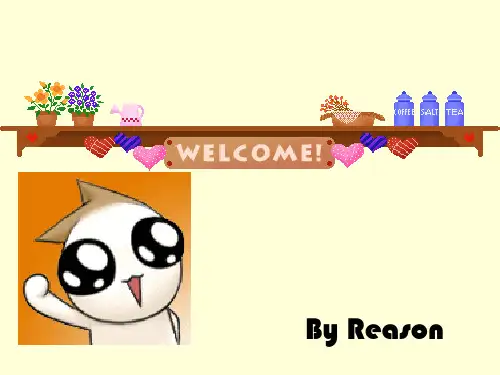
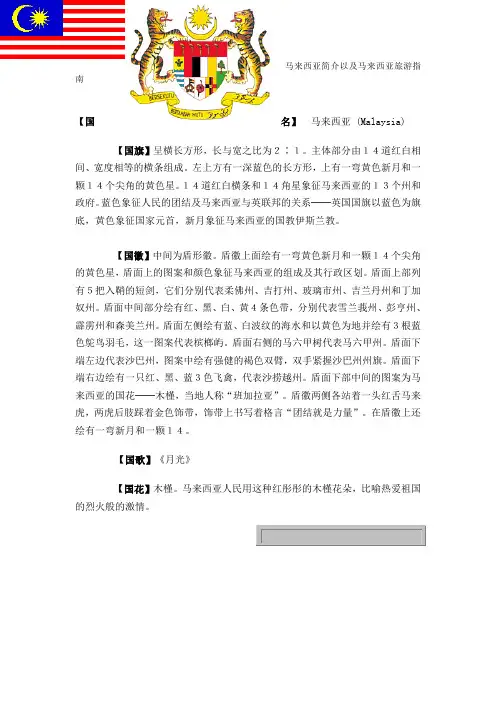
马来西亚简介以及马来西亚旅游指南【国名】 马来西亚 (Malaysia)【国旗】呈横长方形,长与宽之比为2∶1。
主体部分由14道红白相间、宽度相等的横条组成。
左上方有一深蓝色的长方形,上有一弯黄色新月和一颗14个尖角的黄色星。
14道红白横条和14角星象征马来西亚的13个州和政府。
蓝色象征人民的团结及马来西亚与英联邦的关系──英国国旗以蓝色为旗底,黄色象征国家元首,新月象征马来西亚的国教伊斯兰教。
【国徽】中间为盾形徽。
盾徽上面绘有一弯黄色新月和一颗14个尖角的黄色星,盾面上的图案和颜色象征马来西亚的组成及其行政区划。
盾面上部列有5把入鞘的短剑,它们分别代表柔佛州、吉打州、玻璃市州、吉兰丹州和丁加奴州。
盾面中间部分绘有红、黑、白、黄4条色带,分别代表雪兰莪州、彭亨州、霹雳州和森美兰州。
盾面左侧绘有蓝、白波纹的海水和以黄色为地并绘有3根蓝色鸵鸟羽毛,这一图案代表槟榔屿。
盾面右侧的马六甲树代表马六甲州。
盾面下端左边代表沙巴州,图案中绘有强健的褐色双臂,双手紧握沙巴州州旗。
盾面下端右边绘有一只红、黑、蓝3色飞禽,代表沙捞越州。
盾面下部中间的图案为马来西亚的国花──木槿,当地人称“班加拉亚”。
盾徽两侧各站着一头红舌马来虎,两虎后肢踩着金色饰带,饰带上书写着格言“团结就是力量”。
在盾徽上还绘有一弯新月和一颗14。
【国歌】《月光》【国花】木槿。
马来西亚人民用这种红彤彤的木槿花朵,比喻热爱祖国的烈火般的激情。
,2013年5月连任。
4%,基督教、拜物教等。
马来西亚实行君主立宪联邦制。
最高元首为国家首脑、伊斯兰教领袖兼武装部队统帅,由统治者会议从马来西亚9个州的世袭苏丹中选举产生,拥有立法,司法和行政的最高权力,以及任命总理、拒绝同意解散国会等权力,任期5年。
统治者会议由柔佛等九个州的世袭苏丹和马六甲等四个州的州元首组成。
其职能是在九个世袭苏丹中轮流选举产生最高元首和副最高元首;审议并颁布国家法律、法规;对全国性的伊斯兰教问题有最终裁决权;对涉及马来族和沙巴、沙捞越土著民族的特权地位等重大问题进行审议。

马来西亚简介介绍汇报人:日期:•地理与气候•历史与文化•经济与产业目录•社会与人民生活•美食与旅游景点•政治与法律体系01地理与气候地理位置马来西亚位于东南亚,是一个半岛国家。
马来西亚国土位于中南半岛西部,与泰国、新加坡、印度尼西亚等国接壤。
马来西亚的地理位置靠近赤道,处于东经95°-105°和北纬2°30′-7°30′之间。
010204气候特点马来西亚的气候类型主要为热带雨林气候和热带季风气候。
常年高温多雨,四季差异不大。
每年11月至次年3月是雨季,降雨量占全年降雨量的70%-90%。
4月至10月为旱季,降雨量明显减少。
03马来西亚拥有丰富的自然景观,包括热带雨林、珊瑚礁、海滩、山脉等。
马来西亚的海滩以白色沙滩和清澈海水而著名,如巴东岛、热浪岛等。
马来西亚的珊瑚礁是世界上最丰富的珊瑚礁之一,吸引了众多潜水爱好者前来探访。
马来西亚的山区如大汉山国家公园等,有茂密的热带雨林和瀑布等自然景观,是徒步旅行和探险的热门目的地。
自然景观02历史与文化马来人的祖先来自亚洲大陆,通过迁徙和殖民形成了现代的马来族。
马来人的祖先建立王国宗教与文化14世纪,马来人在马来西亚半岛建立了第一个马来王国,标志着马来西亚历史的开始。
马来人的主要宗教是伊斯兰教,同时保留了部分传统信仰和习俗,如巫术和占卜。
030201早期历史16世纪,葡萄牙和荷兰先后占领了马来西亚,带来了欧洲文化和宗教。
欧洲列强到来18世纪末,英国开始对马来西亚进行殖民统治,将该地区纳入其亚洲帝国。
英国殖民统治在英国殖民统治期间,马来人开始组织反抗运动,要求民族独立。
反殖民主义运动殖民地时期国家建设独立后的马来西亚经历了政治、经济和社会变革,努力发展成为一个现代化国家。
独立1957年,马来西亚获得了独立,成为英联邦国家之一。
多元文化马来西亚是一个多元文化的国家,马来人、华人、印度人等不同族群共同构成了丰富多彩的文化景观。
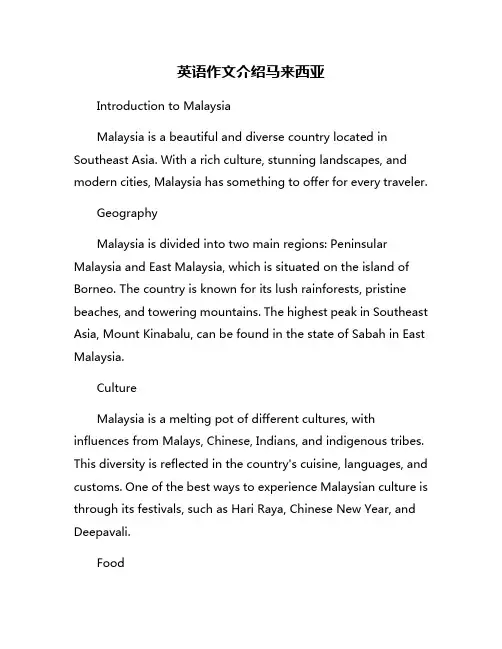
英语作文介绍马来西亚Introduction to MalaysiaMalaysia is a beautiful and diverse country located in Southeast Asia. With a rich culture, stunning landscapes, and modern cities, Malaysia has something to offer for every traveler.GeographyMalaysia is divided into two main regions: Peninsular Malaysia and East Malaysia, which is situated on the island of Borneo. The country is known for its lush rainforests, pristine beaches, and towering mountains. The highest peak in Southeast Asia, Mount Kinabalu, can be found in the state of Sabah in East Malaysia.CultureMalaysia is a melting pot of different cultures, with influences from Malays, Chinese, Indians, and indigenous tribes. This diversity is reflected in the country's cuisine, languages, and customs. One of the best ways to experience Malaysian culture is through its festivals, such as Hari Raya, Chinese New Year, and Deepavali.FoodMalaysia is a paradise for food lovers, with a wide variety of delicious dishes to try. Some of the must-try Malaysian dishes include nasi lemak, roti canai, laksa, and satay. The country's street food scene is also famous, with bustling night markets offering an array of tasty treats.AttractionsMalaysia is home to a number of popular tourist attractions, such as the iconic Petronas Twin Towers in Kuala Lumpur, the historic city of Malacca, and the breathtaking islands of Langkawi. Nature lovers will also find plenty to see and do, with opportunities for jungle trekking, diving, and wildlife spotting.PeopleThe people of Malaysia are known for their warmth and hospitality, making visitors feel welcome wherever they go. Malaysians are proud of their country's diversity and are happy to share their culture with others.In conclusion, Malaysia is a fascinating destination that offers something for every type of traveler. Whether you're interested in exploring vibrant cities, relaxing on beautiful beaches, or immersing yourself in rich cultural traditions,Malaysia has it all. Come and discover the magic of Malaysia for yourself!。
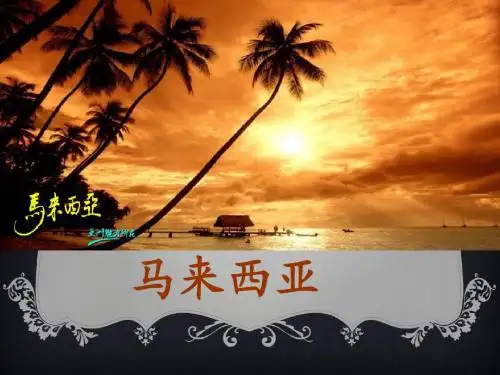
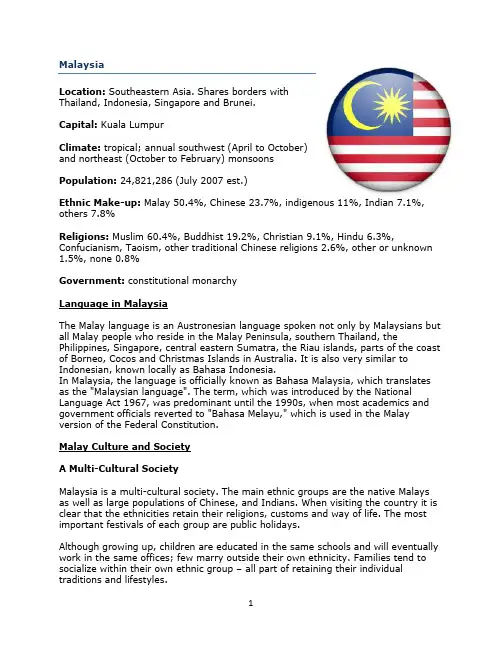
MalaysiaLocation: Southeastern Asia. Shares borders withThailand, Indonesia, Singapore and Brunei.Capital: Kuala LumpurClimate: tropical; annual southwest (April to October)and northeast (October to February) monsoonsPopulation: 24,821,286 (July 2007 est.)Ethnic Make-up: Malay 50.4%, Chinese 23.7%, indigenous 11%, Indian 7.1%, others 7.8%Religions: Muslim 60.4%, Buddhist 19.2%, Christian 9.1%, Hindu 6.3%, Confucianism, Taoism, other traditional Chinese religions 2.6%, other or unknown 1.5%, none 0.8%Government: constitutional monarchyLanguage in MalaysiaThe Malay language is an Austronesian language spoken not only by Malaysians but all Malay people who reside in the Malay Peninsula, southern Thailand, the Philippines, Singapore, central eastern Sumatra, the Riau islands, parts of the coast of Borneo, Cocos and Christmas Islands in Australia. It is also very similar to Indonesian, known locally as Bahasa Indonesia.In Malaysia, the language is officially known as Bahasa Malaysia, which translates as the "Malaysian language". The term, which was introduced by the National Language Act 1967, was predominant until the 1990s, when most academics and government officials reverted to "Bahasa Melayu," which is used in the Malay version of the Federal Constitution.Malay Culture and SocietyA Multi-Cultural SocietyMalaysia is a multi-cultural society. The main ethnic groups are the native Malays as well as large populations of Chinese, and Indians. When visiting the country it is clear that the ethnicities retain their religions, customs and way of life. The most important festivals of each group are public holidays.Although growing up, children are educated in the same schools and will eventually work in the same offices; few marry outside their own ethnicity. Families tend to socialize within their own ethnic group – all part of retaining their individual traditions and lifestyles.Despite the ethnic differences there are commonalities culturally speaking.Group OrientationThe family is considered the center of the social structure. As a result there is a great emphasis on unity, loyalty and respect for the elderly. The family is the place where the individual can be guaranteed both emotional and financial support. When one member of the family suffers a financial setback, the rest of the family will contribute what they can to help out. Families tend to be extended, although in the larger cities this will naturally differ.The Concept of FaceMalays, Chinese and Indians all strive to maintain face and avoid shame both in public and private. Face is a personal concept that embraces qualities such as a good name, good character, and being held in esteem by one's peers. Face is considered a commodity that can be given, lost, taken away, or earned. On top of this face also extends to the family, school, company, and even the nation itself.The desire to maintain face makes Malaysians strive for harmonious relationships.Face can be lost by openly criticizing, insulting, or putting someone on the spot; doing something that brings shame to the group; challenging someone in authority, especially if this is done in public; showing anger at another person; refusing a request; not keeping a promise; or disagreeing with someone publicly. Conversely, face can be saved by remaining calm and courteous; discussing errors or transgressions in private; speaking about problems without blaming anyone; using non-verbal communication to say "no"; and allowing the other person to get out of the situation with their pride intact.Etiquette and Customs in MalaysiaMeeting and GreetingGreetings in a social context will depend upon the ethnicity of the person you are meeting. In general, most Malays are aware of Western ways so the handshake is normal. There may be slight differences though and a few things to bear in mind include:•Malay women may not shake hands with men. Women can of course shake hands with women. Men may also not shake hands with women and may bow instead while placing their hand on their heart.•The Chinese handshake is light and may be rather prolonged. Men and women may shake hands, although the woman must extend her hand first. Many older Chinese lower their eyes during the greeting as a sign of respect.•Indians shake hands with members of the same sex. When being introduced to someone of the opposite sex, nodding the head and smiling is usually sufficient.Among all cultures, there is a general tendency to introduce:o The most important person to the lower ranking person.o The older person to the younger person.o Women to men.NamesThe way names are used also varies between ethnicities:Chinese•The Chinese traditionally have 3 names. The surname (family name) is first and is followed by two personal names.•Many Chinese adopt more Western names and may ask you to use that instead.Malays•Many Malays do not have surnames. Instead, men add their father's name to their own name with the term "bin" (meaning …son of‟). So Rosli bin Suleiman, would be Rosli the son of Suleiman.•Women use the term "binti", so Aysha bint Suleiman is Aysha the daughter of Suleiman.Indian•Many Indians do not use surnames. Instead, they place the initial of their father's name in front of their own name. The man's formal name is their name "s/o" (son of) and the father's name.•Women use "d/o" to refer to themselves as the daughter of their father.Gift Giving EtiquetteHere is some general gift giving etiquette guidelines:Gift giving to Malays:• If invited to someone's home for dinner, bring the hostess pastries or good quality chocolates.• Never give alcohol.• Do not give toy dogs or pigs to children.• Do not give anything made of pigskin.• Avoid white wrapping paper as it symbolizes death and mourning.• Avoid yellow wrapping paper, as it is the color of royalty.• If you give foo d, it must be “halal” (meaning permissible for Muslims).• Offer gifts with the right hand only or both hands if the item is large.• Gifts are generally not opened when received.Gift giving to Chinese:• If invited to someone's home, bring a small gift of fruit, sweets, or cakes, saying that it is for the children.• A gift is traditionally refused before it is accepted to demonstrate that the recipient is not greedy.• Do not give scissors, knives or other cutting utensils as they indicate a desire to sever the relationship.• Flowers do not make good gifts as they are given to the sick and are used at funerals.• Do not wrap gifts in mourning colors - white, blue, or black.• Wrap the gifts in happy colors - red, pink, or yellow.• Elaborate gift - wrapping is imperative.• Never wrap a gift for a baby or decorate the gift in any way with a stork, as birds are the harbinger of death.• It is best to give gifts in even numbers since odd numbers are unlucky.• Gifts are generally not opened when received.Gift giving to Indians:• If you give flowers, avoid frangipani as they are used in funeral wreaths.• Money should be given in odd numbers.• Offer gifts with the right hand only or both hands if the item is large.• Do not wrap gifts in white or black.• Wrap gifts in red, yellow or green paper or other bright colors bring good fortune. • Do not give leather products to a Hindu.• Do not give alcohol unless you are certain the recipient drinks.• Gifts are generally not opened when received.Business Etiquette and Protocol in MalaysiaMeeting and GreetingWithin the business context most Malaysian businesspeople are culturally-savvy and internationally exposes. Your experience may very well depend upon the ethnicity, age, sex and status of the person you are meeting. The best approach is always friendly yet formal. A few tips include:• Initial greetings should be formal and denote proper respect.• If in a team, introduce the most important person first.• Many Malays and Indians are uncomfortable shaking hands with a member of the opposite sex.• Foreign men should always wait for a Malaysian woman to extend her hand. Foreign women should also wait for a Malaysian man to extend his hand.• To demonstrate respect Chinese may look downwards rather than at the person they are meeting.• It is important that professional titles (professor, doctor, and engineer) and honorific titles are used in business. Malays and Indians use titles with their first name while Chinese use titles with their surname.Business Card Etiquette• Business cards are exchanged after the initial introductions.• If you will be meeting Chinese, have one side of your card translated into Chinese, with the Chinesecharacters printed ingold.• If you will bemeetinggovernment officials,have one side ofyour card translatedinto BahasaMalaysia.• Use two hands orthe right hand onlyto exchangebusiness cards.• Examine anybusiness card youreceive beforeputting it in yourbusiness card case.• The respect youshow someone'sbusiness card isindicative of therespect you will show the individual in business. Act accordingly.• Never write on someone's card in their presence.CommunicationAs an extension to the need to maintain harmonious relations, Malaysians rely on non-verbal communication (i.e. facial expressions, tone of voice, body language, etc.). Such a communication style tends to be subtle, indirect and. Malays may hint at a point rather than making a direct statement, since that might cause the other person to lose face. Rather than say "no", they might say, "I will try", or "I‟ll see what I can do". This allows the person making the request and the person turning it down to save face and maintains harmony in their relationship.If you are unsure about the affirmative response you received, you may want to continue the discussion, re-phrasing the question in several different ways so that you may compare responses. If the response was given because the Malaysian did not know how to respond in the negative without causing offense, this may come out. Alternatively, they may have someone else give you the bad news.Silence is an important element of Malaysian communication. Pausing before responding to a question indicates that they have given the question appropriate thought and considered their response carefully. Many Malaysians do not understand the Western propensity to respond to a question hastily and can consider such behavior thoughtless and rude. Malaysians may laugh at what may appear to outsiders as inappropriate moments. This device is used to conceal uneasiness.Do not show anger in public as it makes Malaysians uncomfortable and creates a feeling of powerlessness. There is a greater chance of achieving a good outcome id you are calm, whereas little is resolved by shouting.Business Meetings•It is a good idea for the most senior person on your team to enter first so that he or she is the first to greet the most senior Malaysian.•This gives face to both parties as it demonstrates respect towards the Malaysian and shows that you respect hierarchy within your company.•It is customary for leaders to sit opposite each other around the table.•Many companies will have their team seated in descending rank, although this is not always the case.•Expect the most senior Malaysian to give a brief welcoming speech. You need not reciprocate.•There will be a period of small talk, which will end when the most senior Malaysian is comfortable moving to the business discussion.•Meetings may be conducted or continue over lunch and dinner.•Meetings, especially initial ones, are generally somewhat formal. Treat all Malaysian participants with respect and be cautious not to lose your temper or appear irritated.•At the first meetingbetween two companies,Malaysians willgenerally not get intoin-depth discussions.They prefer to use thefirst meeting as anopportunity to get toknow the other side andbuild a rapport, which isessential in thisconsensus-drivenculture.。
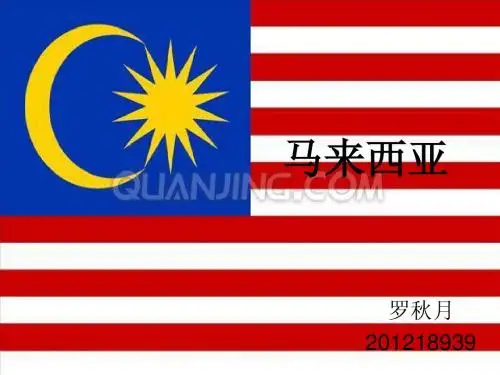
马来西亚概述马来西亚概述⼀、⼈⽂与地理(⼀)地理位置马来西亚,简称⼤马,东南亚的国家之⼀。
马来西亚是⼀个由⼗三州和三个联邦直辖区组成的联邦体制国家,⾯积有329,845平⽅公⾥。
马来西亚共分为两⼤部分,之间有南中国海相隔:⼀个是位于马来半岛的西马来西亚,北接泰国,南部隔着柔佛海峡,以新柔长堤和第⼆通道与新加坡接壤;另⼀个是东马来西亚,位于婆罗洲岛上的北部,南邻印度尼西亚的加⾥曼丹,⽽⽂莱国则地处沙巴州和砂拉越州之间,由于马来西亚的地理位置接近⾚道,故马来西亚的⽓候属于亚洲热带型⾬林⽓候。
⾸都吉隆坡,布城是联邦政府所在地。
(⼆)⾃然环境整个马来西亚属热带⾬林⽓候,终年炎热多⾬。
沿海地区还受到西南季风和东北季风的交替影响。
马来西亚主要由中间隔着中国南海的东马来西亚(沙巴及砂拉越)及西马来西亚(马来半岛)组成。
马来西亚⼤部分的沿海地区都是平原,中部则是布满茂密热带⾬林的⾼原。
最⾼⼭峰是处于沙巴州的基纳巴卢⼭。
马来西亚靠近⾚道,⽓候潮湿炎热。
每年四⽉⾄⼗⽉间吹西南风,⼗⽉⾄⼆⽉间吹东北风。
马来西亚⼤部分的沿海地区都是平原,中部则是布满茂密热带⾬林的⾼原。
最⾼⼭峰是处于沙巴州的吉纳巴奴⼭。
马来西亚靠近⾚道,⽓候潮湿炎热。
每年四⽉⾄⼗⽉间吹西南风,⼗⽉⾄⼆⽉间吹东北风。
马来西亚海岸线长4192km。
马来半岛中为⼭地,两侧为平原,沿海沼泽⼴布。
马来西亚在加⾥曼丹岛北部主要由砂拉越和沙巴组成,其沿海多为平原,内地多为森林覆盖的丘陵和⼭地。
马来西亚最⾼峰为基纳巴卢⼭(马来西亚称为京那巴鲁⼭或神⼭),位于沙巴,海拔4101⽶。
河流主要有霹雳河、彭亨河(马来半岛最长河流)、拉让江(砂拉越最长河流)、基纳巴唐岸河(莎巴最长河流,⾺來西亞稱為京那峇當岸河)等。
(三)⾃然资源马来西亚⾃然资源丰富。
橡胶、棕油和胡椒的产量和出⼝量居世界前列。
曾是世界产锡⼤国,但近年来产量逐年减少,2004年锡产量为3500吨。
截⾄2005年1⽉1⽇,马来西亚⽯油和天然⽓总储量为194.9亿桶,可供分别开采19年和33年。
马来西亚英文介绍:Malaysia is located in Southeast Asia. Its territory is divided into two parts by the South China Sea, i.e.the Malay Peninsula and the north of Kalimantan island. The national coastline is 4192 kilometers long. It belongs to tropical rainforest climate.On August 31, 1957, Dong Gu abdulman declared the independence of the United States of Malaya.in 1963, the United States of Malaya, together with Singapore, Sabah and Sarawak, formed the Federation of Malasia The highest representative of the state at home and abroad is called the head of state, and the head of government is the prime minister.It is a multi-ethnic and multi-cultural country. Although the official religion is Islam, the national religious freedom is guaranteed by the Malaysian constitution.Damascus is a capitalist country. Its economy developed rapidly in the 1990s. It is one of the four tigers in Asia.It has become an attractive diversified emerging industrial country in Asia and an emerging market economy in the world.The State implements the new economic policy of giving priority to the Malay and indigenous peoples.。
史上最全马来西亚中英双语介绍HistoryThe earliest recorded Malay kingdoms grew from coastal city-ports established in the 10th century AD. It is thought that originally these were Hindu or Buddhist nations. Islam arrived in the 14th century in Terengganu. In the early part of the 15th century, the Sultanate of Malacca was established under a dynasty started by a prince by the name of Parameswara from Palembang. The sultanate controlled the areas which are now Peninsula Malaysia, southern Thailand (Patani), and the eastern coast of Sumatra. It existed for more than a century, and within that time period Islam spread to most of the Malay archipelago. Portugal made Malacca a colony in 1511 by military conquest, thus ending the Sultanate of Malacca. After the fall of Malacca, three nations struggled for the control of Malacca Strait: The Portuguese (in Malacca), the Sultanate of Johor and the Sultanate of Aceh. This conflict went on till 1641, when the Dutch (allied to the Sultanate of Johor) gained control of Malacca. The British took control of Malacca after the Anglo-Dutch Treaty of 1824. The British Crown Colony of the Straits Settlements was established in 1826, and Britain increased its control over the rest of the peninsula.By the turn of the 20th century, the states of Pahang, Selangor, Perak, and Negeri Sembilan, known together as the Federated Malay States, were under the rule of British residents appointed to advise the rulers/Sultans.. The other Peninsular states were known as the Unfederated Malay States and, while not directly under rule from London, had British advisors in the Sultans" courts. The four northern states of Perlis, Kedah, Kelantan, and Terengganu were previously under Thai control. British North Borneo (currently the state of Sabah) was a British Crown Colony formerly under the rule of the Sultanate of Sulu, whilst the territory of Sarawak was the personal fiefdom of the Brooke (White Rajah) family.The Malay Peninsular was occupied by Japan from 1942 to 1945. Following the Japanese occupation, the popular support for independence grew, coupled with a communist insurgency. In 1948, the British-ruled territories on the Malay Peninsula formed the Federation of Malaya, which became independent in 1957. Malaysia was formed in 1963 when the former British colonies of Singapore and the East Malaysian states of Sabah and Sarawak on the northern coast of Borneo joined the Federation. The first several years of the country’s history were marred by Indonesian efforts to control Malaysia, Philippine claims to Sabah, and Singapore’s secession from the Federation in 1965.历史最早有所记录的马来王国是在公元后十世纪的港口城市发展起来的。
它最初被认为是印度教和佛教国家。
伊斯兰教在十四世纪进入大马丁加奴(Terengganu)。
在十五世纪初期,马六甲海峡的伊斯兰君主地是苏门答腊的巨港(Palembang)的拜里米苏拉(Parameswara)王子所开始的王朝被建立起来的。
那时的伊斯兰君主领地所管辖的就是现在的马来群岛,南泰,和苏门答腊岛的南岸。
它存在了一个多世纪,并且在其期间,伊斯兰教在马来群岛广为传播。
1511年,葡萄牙战胜,马六甲海峡成了其殖民地,从此结束了马六甲海峡的伊斯兰君主制。
马六甲失守后,三个国家为了马六甲海峡的控制权争斗:葡萄牙人,柔佛州(Johor)和亚齐(Aceh)的伊斯兰教君主。
这场战争一直持续到1641年,最终和柔佛州联盟的荷兰人获得了胜利。
在1824年签订的英荷之后,马六甲海峡的控制权转到了英国人手中。
在1826年建立了英属海峡殖民地的英国直辖殖民地,并且英国的控制扩张至其余的半岛。
在十九世纪末二十世纪初期,彭亨州(Pahang), 雪兰莪州(Selangor), 霹雳州(Perak)和森美兰州(Negeri Sembilan)组成了马来联合国,为英国所指定的统治者的领导。
其余的一些未同盟的半岛国家虽然不直接在伦敦的控制下但在最高法院都有英国顾问。
北方的四个州玻璃市州(Perlis), 吉打(Kedah), 吉兰丹州(Kelantan),和丁加奴(Terengganu )先前是在泰国的控制下。
英国的北婆罗洲(现今名为沙巴州Sabah)先前是在苏禄人统治下的英国直辖殖民地,同时砂劳越(Sarawak)曾经是布鲁克家族的私人封地。
马来半岛在1942年到1945年被日本占领。
被日本占领后,要求独立的呼声越来越高,外加共产主义的叛乱。
1948年,英国制定的马兰半岛形成了马来半岛联合国,它在1957年独立。
1963年,当先前的英国殖民地新加坡,还有位于婆罗洲北海岸的东马来国家沙巴和砂劳越加入联盟后,马来西亚诞生了。
马来西亚前几年的建国历史受到印度尼西亚尝试控制马来西亚, 菲律宾认沙巴州为其主权地和新加坡在1965年宣告脱离联盟所影响。
GeographyMalaysia is a country in Southeast Asia. It consists of two geographical regions, West and East Malaysia, divided by the South China Sea. West Malaysia (Peninsular Malaysia or Malay Peninsula) shares a land border on the north with Thailand and is connected by the Johor Causeway and the Tuas Second Link on the south withSingapore. :East Malaysia, consisting of the federal territory of Labuan and the states of Sabah and Sarawak, occupies the northern part of the island of Borneo, bordering Indonesia and the Sultanate of Brunei.Both West and East Malaysia feature coastal plains rising to often densely forested hills and mountains, the highest of which is Mount Kinabalu at 4,095.2 m on the island of Borneo.地理马来西亚位于亚洲东南部。
它由东,西马来群岛两个地理区域组成,东,西马来群岛被中国南海(south china sea)所隔。
堤道和大士的第二通道(Tuas Second link)从南方和新加坡相连。
东马来群岛是由联邦地域中的纳闽岛和沙巴诸州还有沙捞越组成的,它占据了婆罗洲诸岛的南部,接壤着印度尼西亚和文莱。
东、西马拉半岛都是以沿海平原上接到草木丛生的丘陵和大山为特色,最高的山是位于婆罗洲岛的海拔4,095.2米的京那Q山(Gunung Kinabalu)又Q神山。